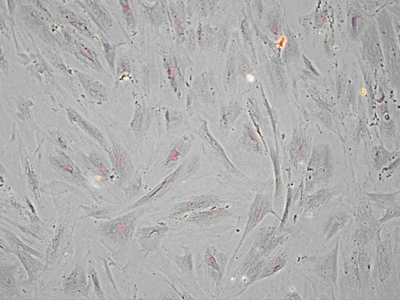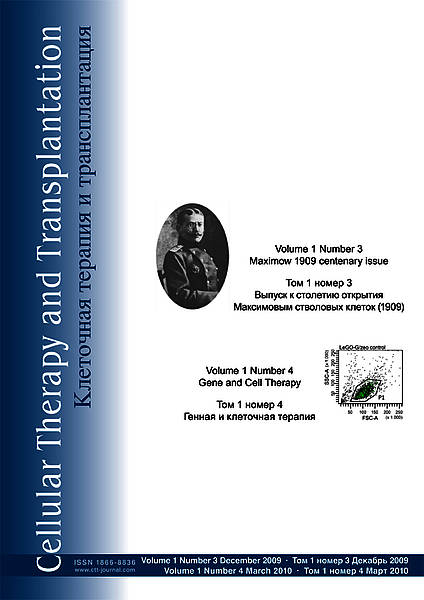The MSCs' in vitro community: where to go?
Sascha Lange, Axel R. Zander, Claudia Lange
Clinic for Stem Cell Transplantation, University Medical Center Hamburg-Eppendorf, Germany
Correspondence:
Claudia Lange, Clinic for Stem Cell Transplantation, University Medical Center Hamburg-Eppendorf, Martinistr. 52, 20246 Hamburg, Germany, E-mail: cllange@uke.uni-hamburg.de
Accepted 12 February 2010
Published 12 February 2010
Summary
Human mesenchymal stromal cells (hMSC) are presently being investigated extensively for their potential use as cellular therapeutics in regenerative medicine. They can be easily isolated, e.g., from bone marrow by plastic adherence, and expanded in vitro. These videos show the proliferation of hMSC, and how they interact with each other and divide. The large distances hMSC can conquer call into question the cloning carried out by low-density seeding.
Keywords
Mesenchymal stem cells, hmsc, proliferation, in vitro division, time lapse
Video description
Human mesenchymal stromal cells (hMSCs) are presently being investigated extensively for their potential use as cellular therapeutics in regenerative medicine. Although a unique marker for prospective isolation of hMSC is still lacking, they can be easily isolated by plastic adherence from bone marrow and other tissues. Furthermore, hMSCs are capable of expanding in vitro as undifferentiated cells [1]. In vitro, human MSCs are heterogeneous in that they contain morphologically distinct kinds of cells: spindle-shaped and large cuboidal or flattened cells. Colter et al. described an additional population of small and rounded cells with rapidly self-renewing capacity [2].
Some therapeutic approaches have demonstrated the ability of MSCs to regenerate injured tissues [3, 4]. Transplantation experiments in mice and primates have shown that intravenously administered MSCs distribute to several tissues. This implies that MSCs are not only able to migrate but also that the direction of migration is controlled. This migration ability is highly dependent on the flexibility of the cell. For example, basic fibroblast growth factor (bFGF) applied in vitro has been shown to influence not only an attraction but also routing of MSCs by manipulating the orientation of the cytoskeleton. Basic FGF attracted the MSCs by directly influencing the migratory ability through a parallel-orientation of the cells' actin filament [5]. In contrast, the inhibition of the FGF pathway indirectly might cause differentiation [6].
Recently, several factors have been identified which mediate homing and migration of MSCs to injured tissues. For example, ischemia-reperfusion-induced acute kidney injury leads to an increase of the stroma-derived factor 1 (SDF-1) expression in the kidney. At the same time, SDF-1 expression decreases in the bone marrow, thereby reversing the normal gradient between bone marrow and the periphery, and thus mediating homing to the injured tissue and migration of MSCs expressing SDF-1 receptor CXCR4 [7]. Additionally, MSCs were strongly attracted by hepatocyte growth factor (HGF) gradients as well, and proved their chemo-invasiveness across a reconstituted basement membrane in vitro [8]. These results suggest that the SDF-1-CXCR4 and HGF-c-met axes may be involved in recruitment of expanded MSCs for damaged tissues. Finally, the investigation of the traversal mechanism by which MSCs migrate into injured tissues revealed that both P-selectin and VCAM-1 are equally required for this process. Here, MSCs were able to roll and adhere to post-capillary venules in vivo showing similar migratory behaviour to leukocytes [9].
The presented videos show the proliferation of hMSC kept in DMEM-low glucose with fetal calf serum as described (1). Pictures were taken in the phase-contrast mode every 15 min for a time period of 2 days from cultures incubated on an Olympus IX81 microscope equipped with incubation chamber and SIS software. In video 1, on the right picture's edge, a large flattened cell remains almost stationary for the complete recording time. It communicates, “pulsing” with neighbouring cells by extending protrusions forming filopodiae/lobopodiae/lamellopodiae, coming close together or only contacting slightly at the surface. In this cell, the floating changes of the cell body are visible, combined with changes of the nucleus location. The cytoplasmic changes suggest an active orientation of actin-fibers, visible as dark lines directed to the outer borders of the cell. The high count of actin-fibers is particularly characteristic for cells that are not undergoing any more cell division but possibly serving as “nursery” cells. The actin fibers can regularly be observed in old and stressed cultures of hMSC as well (Fig.1).

Figure 1. hMSC culture after prolonged propagation. Ageing cultures show a majority of flattened cells with actin fibres along the cell body. No small and round cells are visible, suggesting a stationary phase of this culture.
Departing cells might leave behind molecular signatures in form of extra-cellular matrices seen as dark-gray lines without any cell body. These traces often are “visited” by trampers, sometimes taking up particles of the traces, sometimes "sniffing" only and continuing on their way. The vagabonds easily might travel more than 500 µm, themselves being only a few µm in size. The length of other cells might reach 300‒600 µm (see upper quarter, video 1), with a width of only ca. 5 µm. During the travel, cells might condense, forming small and round, only loosely adherent cells (see lower quarter, Video 1).
Video 1.
This is the moment when cells prepare for division. The cell divisions itself takes roughly 15‒20 min, and afterwards the new 2 daughter cells either continue to travel as long stretched or short cells or stay in place and provide contact and information to other arriving cells. It is known that MSCs itself express SDF-1 and HGF. Although we do not show stainings for these factors, they might be one part of the interaction of MSCs seen in vitro.
In video 2, the initial cell number was higher, the pictures taken every 10 min for a time period of 2 days, and the cell body shown in semi-3D-dimensionality. Here, the video shows the active interaction of MSCs.
Video 2.
The observer has the impression of witnessing a highly communicative community where the members have a lively exchange experience. The movements of MSCs are accompanied by 1. change of cell shape, 2. polymerisation of cellular actin, 3. formation of lamellopodiae at the leading edge, 4. concentration of the main cell body on the leading edge, and 5. movement of the whole cell body via 6. formation of uropodiae at the lateral edge. The whole process of the MSCs' proliferation and movement observed in vitro is similar to that described for leukocytes during the process of homing to inflamed tissues. Thus, our results support the notion of similar behaviour of MSCs and leukocytes.
However, the high motility of MSCs in vitro also suggests that cloning with cloning rings even at low density of 1‒5 cells/cm2 might not lead to the pure clonal populations clearly derived from 1 cell only. Single travellers easily might contaminate colonies. Therefore, we suggest a more rigid cloning technique either by seeding a limited number of mononuclear cells (MNCs), supposed that the MSC frequency in MNCs is 1/104‒105 or by rigid cloning of 0.3 cells/well and regular observation of the forming clones.
Acknowledgements
This work was supported by the Federal Ministry of Education and Research Germany; Contract grant number: 13N8904 (HyCelex). We thank B. Brunswig-Spickenheier for critical reading of the manuscript.
References
1. Lange C, Cakiroglu F, Spiess AN, Cappallo-Obermann H, Dierlamm J, Zander AR. Accelerated and safe expansion of human mesenchymal stromal cells in animal serum-free medium for transplantation and regenerative medicine. J Cell Physiol. 2007;213(1):18-26.
6. Bendall SC, Stewart MH, Menendez P, George D, Vijayaragavan K, Werbowetski-Ogilvie T, Ramos-Mejia V, Rouleau A, Yang J, Bossé M, Lajoie G, Bhatia M. IGF and FGF cooperatively establish the regulatory stem cell niche of pluripotent human cells in vitro. Nature. 2007;448(7157):1015-21.


